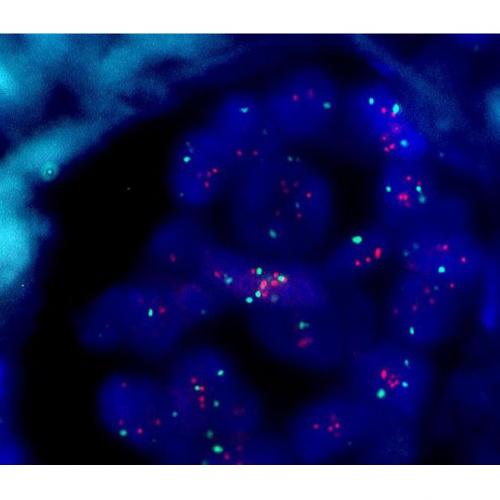
Fluorescence in Situ Hybridization
FISH is a technique that measures gene amplification using fluorescently labeled DNA (probe). The sample of breast tumor tissue is prepared for FISH by heating it. This heating process breaks the DNA into two strands; this produces two single strands of DNA and is called denaturing. The labeled probe is added to the denatured DNA mixture. The fluorescently labeled DNA matches certain regions of the denatured DNA and when the matching regions come in contact with each other they stick together. The mixture is washed so any unbound labeled DNA is removed. The washed mixture is viewed using a special microscope that can detect the color emitted by the probe. The probe marks the areas of DNA (genes) that code for the protein of interest, thus the amount of probe bound to the DNA is an indirect indicator of the number of genes present coding for the protein.1, 2, 3
In the video above, chromosomes from the cells of a patient are mixed with test DNA. The test DNA is linked to a protein that binds to a colored dye. If the test DNA finds and binds similar sequences in the patient's DNA, it can be identified by adding the dye to the chromosomes.
FISH is a fast and highly sensitive technique that provides an objective scoring system. It is more expensive than IHC and requires a fluorescence microscope for interpretation, so it is not available in all areas.1, 2, 3
FISH for determination of HER2 status in breast cancer
In the case of HER2 status of breast cancer, the labeled DNA probe is binds to the DNA region coding for the HER2 protein. Pathologists can determine the number of HER2 genes present by measuring the amount of probe in the sample. A tumor is considered HER2 positive if a sample has over 2 copies of the HER2 gene per chromosome 17.1
A sample of an entire set of chromosomes that has been labeled with different colored dyes using a variation of the FISH technique is shown below:

- 1abc DG Hicks, RR Tubbs. Assessment of the HER2 status in breast cancer by fluorescence in situ hybridization: a technical review with interpretive guidelines. Human Pathology. 2005 Mar;36(3):250-61. [PUBMED]
- 2ab DG Hicks, RR Tubbs. Assessment of the HER2 status in breast cancer by fluorescence in situ hybridization: a technical review with interpretive guidelines. Human Pathology. 2005; 36:250-261. [PUBMED]
- 3ab M Bilous, M Dowsett, et al. Current Perspectives on HER2 Testing: A Review of National Testing Guidelines. Modern Pathology. 2003; 16(2):173-182. [PUBMED]
